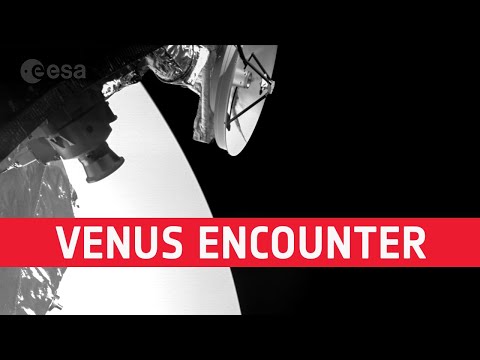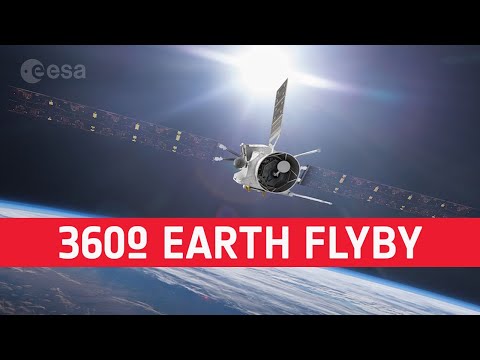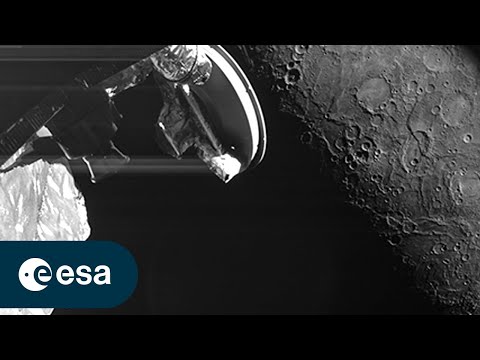BepiColombo’s second Mercury flyby
A beautiful sequence of 56 images taken by the monitoring cameras on board the ESA/JAXA BepiColombo mission as the spacecraft made its second close flyby of its destination planet Mercury on 23 June 2022.
The compilation includes images from two monitoring cameras (MCAM) onboard the Mercury Transfer Module, which provides black-and-white snapshots at 1024 x 1024 pixel resolution. The MCAMs also capture parts of the spacecraft: MCAM-2 sees the Mercury Planetary Orbiter’s medium-gain antenna and magnetometer boom, while the high-gain antenna is in the MCAM-3 field-of-view.
The image sequences lasted about 15 minutes starting soon after closest approach to Mercury, which was at an altitude of 200 km. The first sequence showcases images taken by MCAM-2, starting from a distance of around 920 km from the surface of the planet and finishing at about 6099 km. The second sequence shows images from MCAM-3 covering a similar distance range (approximately 984 km – 6194 km).
Since MCAM-2 and MCAM-3 are located on either side of the spacecraft, and the image acquisition alternated quickly between the two cameras with about 15-20 seconds between them, the final sequence shows a composite of the two views, giving an impression of the complete planet receding behind the spacecraft.
During the flyby it was possible to identify various geological features that BepiColombo will study in more detail once in orbit around the planet. While craters dominate the landscape, numerous volcanic plains can also be made out, as well as roughly linear ‘scarps’ – cliff-like features created by tectonic faulting. In this flyby, the planet’s largest impact basin Caloris was seen for the first time by BepiColombo, its highly-reflective lavas on its floor making it stand out against the darker background as it rotated into the MCAM-2 field of view.
The gravity assist manoeuvre was the second at Mercury and the fifth of nine flybys overall. During its seven-year cruise to the smallest and innermost planet of the Solar System, BepiColombo makes one flyby at Earth, two at Venus and six at Mercury to help steer it on course to arrive in Mercury orbit in 2025. The Mercury Transfer Module carries two science orbiters: ESA’s Mercury Planetary Orbiter and JAXA’s Mercury Magnetospheric Orbiter. They will operate from complementary orbits to study all aspects of mysterious Mercury from its core to surface processes, magnetic field and exosphere, to better understand the origin and evolution of a planet close to its parent star.
All images are also available in the Planetary Science Archive: https://archives.esac.esa.int/psa/#!Image%20View/MCAM=instrument
Read more about the flyby here: https://www.esa.int/Science_Exploration/Space_Science/BepiColombo/Second_helpings_of_Mercury
Credit: Image: ESA/BepiColombo/MTM, CC BY-SA 3.0 IGO; Music composed and performed by Anil Sebastian and Ingmar Kamalagharan.
★ Subscribe: http://bit.ly/ESAsubscribe and click twice on the bell button to receive our notifications.
Check out our full video catalog: http://bit.ly/SpaceInVideos
Follow us on Twitter: http://bit.ly/ESAonTwitter
On Facebook: http://bit.ly/ESAonFacebook
On Instagram: http://bit.ly/ESAonInstagram
On LinkedIn: https://bit.ly/ESAonLinkedIn
On Pinterest: https://bit.ly/ESAonPinterest
On Flickr: http://bit.ly/ESAonFlickr
We are Europe’s gateway to space. Our mission is to shape the development of Europe’s space capability and ensure that investment in space continues to deliver benefits to the citizens of Europe and the world. Check out https://www.esa.int/ to get up to speed on everything space related.
Copyright information about our videos is available here: https://www.esa.int/ESA_Multimedia/Terms_and_Conditions
#BepiColombo
#Mercury
#Flyby





Great Capture of little burned rocky Mercury so close to the Sun – . – /, well done ESA
Its weird it got so many craters normally the sun will take it all by gravity, in respect merurcy is in the way.
Most of the craters are from the late bombarment or impacts afterwards ?
looked like the wu tang clan simbol lol
HEY! That looks like the moon.
great times!
So close, yet still so far.
Amazing !
Thanks for the share ESA ! I hope you've enjoyed this round. Please consider overlaying speed, distance, energy levels, etc to get us earthlings closer to BepiColombo's experience
This is only the 3rd Mercury mission ever.
Mariner 10, MESSENGER, and then this.
Incrível …
They had to do it at night.
It would be so cool if we could send a crewed mission to Mercury someday.
Looks identical to the moon? Well to me anyway. I thought it was just an asteroid for a minute, I didn’t think it was a planet.
Mercury always alone must be very excited waiting for this new human machine visit ..see you soon little and dear planet…
Solo una parola… Wow!
Totally amazing We serve an awesome God 🙏🙏🕊️❤️